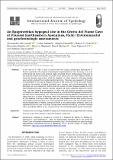| dc.contributor.author | Montanari, Alessandro | |
| dc.contributor.author | Adamek, Artur | |
| dc.contributor.author | Curatolo, Angelo | |
| dc.contributor.author | Ferretti, Marco | |
| dc.contributor.author | Mainiero, Maurizio | |
| dc.contributor.author | Mariani, Sandro | |
| dc.contributor.author | Pignocchi, Gaia | |
| dc.contributor.author | Recanatini, Stefano | |
| dc.contributor.author | Mcgee, David | |
| dc.date.accessioned | 2023-02-17T18:21:49Z | |
| dc.date.available | 2023-02-17T18:21:49Z | |
| dc.date.issued | 2020 | |
| dc.identifier.uri | https://hdl.handle.net/1721.1/148112 | |
| dc.description.abstract | <jats:p>In the late fall of 1986, a team of cavers from the Gruppo Speleologico Marchigiano of Ancona reported to the regional Archeological Superintendence their discovery in a room of the Grotta del Fiume Cave (Marche region of central Italy) of archeological finds such as the charcoal remains of a bonfire, a number of ibex bones, and four chert artifacts. However, since the discovery and archival of all this material, no further research or focused studies were carried out about this important archeological site. Therefore, we engaged in a thorough re-examination of this site by mapping this part of the Grotta del Fiume Cave with modern surveying approaches, including terrestrial laser scanner and ground penetrating radar. Moreover, we have radiocarbon dated a few ibex bones and also charcoal samples from the main fireplace and other smaller charcoal deposits we found scattered around the room’s floor. The chert artifacts were examined in detail and their typology classified accordingly. U-Th dating of calcite from speleothems helped us reconstruct this hypogeal environment at the time it was frequented by man. We also studied a puzzling deposit of speleothem crust slabs piled up in a corner of the cave, which may represent a funeral earthen mound. All in all, the absence of artifacts other than the four chert blades, the few ibex bones, the one main fireplace and three other minor charcoal deposits in the room, and the probable earthen mound located tens of meters underground from a now debris-sealed entrance, lead us to hypothesize that this cave room does not represent a residential dwelling but rather a worship place sporadically utilized by few representatives of a local Epigravettian hunter community.</jats:p> | en_US |
| dc.language.iso | en | |
| dc.publisher | University of South Florida Libraries | en_US |
| dc.relation.isversionof | 10.5038/1827-806X.49.2.2324 | en_US |
| dc.rights | Creative Commons Attribution NonCommercial License 4.0 | en_US |
| dc.rights.uri | https://creativecommons.org/licenses/by-nc/4.0/ | en_US |
| dc.source | International Journal of Speleology | en_US |
| dc.title | An Epigravettian hypogeal site in the Grotta del Fiume Cave at Frasassi (northeastern Apennines, Italy): Environmental and geochronologic assessments | en_US |
| dc.type | Article | en_US |
| dc.identifier.citation | Montanari, Alessandro, Adamek, Artur, Curatolo, Angelo, Ferretti, Marco, Mainiero, Maurizio et al. 2020. "An Epigravettian hypogeal site in the Grotta del Fiume Cave at Frasassi (northeastern Apennines, Italy): Environmental and geochronologic assessments." International Journal of Speleology, 49 (2). | |
| dc.contributor.department | Massachusetts Institute of Technology. Department of Earth, Atmospheric, and Planetary Sciences | en_US |
| dc.relation.journal | International Journal of Speleology | en_US |
| dc.eprint.version | Final published version | en_US |
| dc.type.uri | http://purl.org/eprint/type/JournalArticle | en_US |
| eprint.status | http://purl.org/eprint/status/PeerReviewed | en_US |
| dc.date.updated | 2023-02-17T17:54:00Z | |
| dspace.orderedauthors | Montanari, A; Adamek, A; Curatolo, A; Ferretti, M; Mainiero, M; Mariani, S; McGee, D; Pignocchi, G; Recanatini, S | en_US |
| dspace.date.submission | 2023-02-17T17:54:12Z | |
| mit.journal.volume | 49 | en_US |
| mit.journal.issue | 2 | en_US |
| mit.license | PUBLISHER_CC | |
| mit.metadata.status | Authority Work and Publication Information Needed | en_US |
